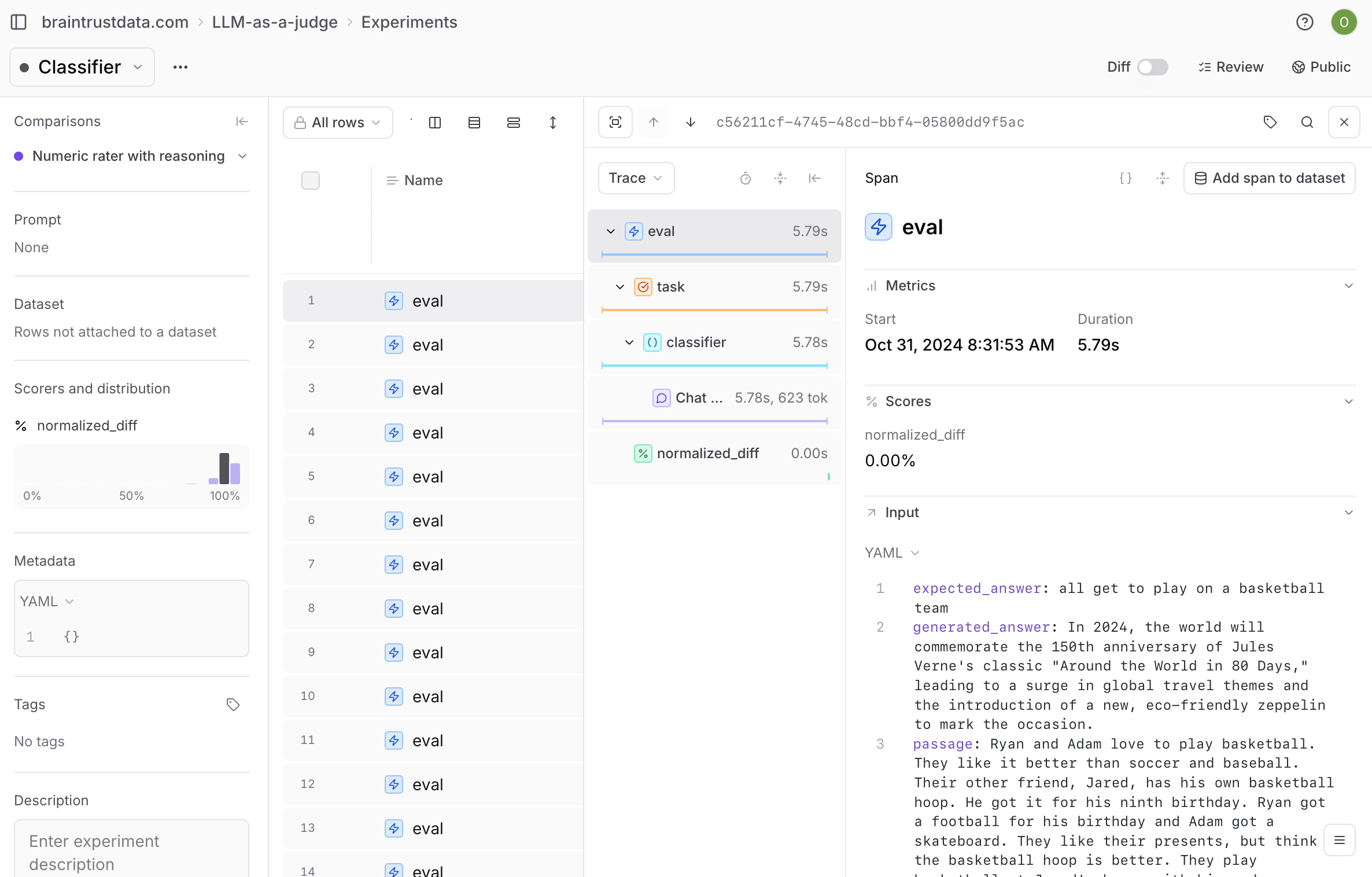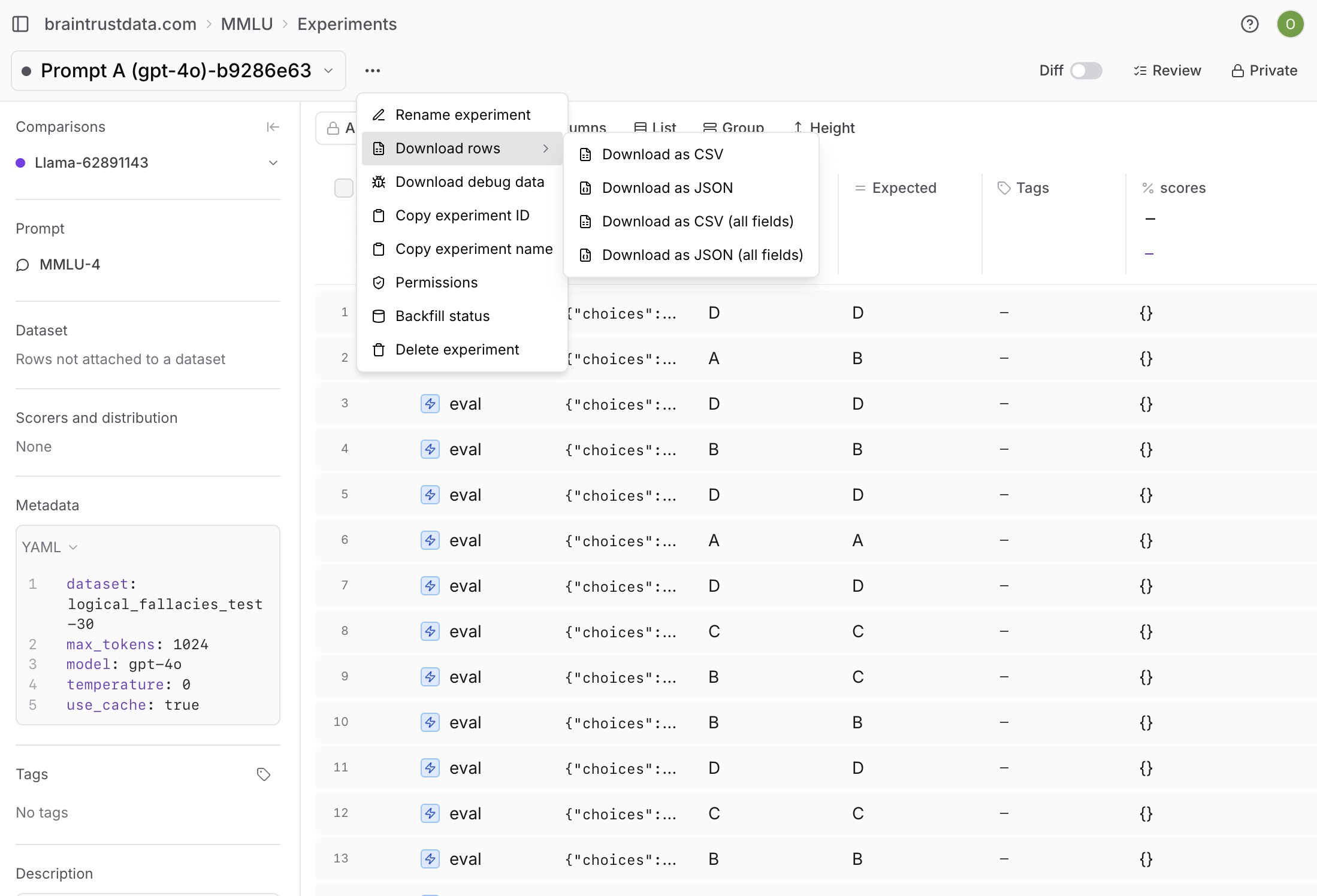View summaries
The summary pane displays:- Comparisons to other experiments
- Scorers used in the evaluation
- Datasets tested
- Metadata like model and parameters
Understand metrics
Braintrust tracks these metrics automatically:- Duration: Time to complete the task span
- Offset: Time elapsed since trace start
- Prompt tokens: Tokens in the input
- Completion tokens: Tokens in the output
- Total tokens: Combined token count
- LLM duration: Time spent in LLM calls
- Estimated cost: Approximate cost based on pricing
task subspan, excluding LLM-as-a-judge scorer calls.
To compute LLM metrics, wrap your LLM calls with Braintrust provider wrappers.
Change the display
Switch the view
Each project includes locked default views that cannot be modified, including:- Non-errors: Shows only records without errors
- Errors: Shows only records with errors
- Scorer errors: Shows only records with scorer errors
- Unreviewed: Hides items that have been human-reviewed
- Assigned to me: Shows only records assigned to the current user for human review
- To set the current view as default, select Manage view > Set as your default view.
- To discard unsaved changes and return to the default view, select Reset.
Create a custom view
Custom views save your table configurations including filters, sorts, column order, column visibility, and display settings. This lets you quickly switch between different ways of analyzing your experiments. To create a custom view:- Apply the filters, sorts, columns, and display settings you want.
- Select Save as in the toolbar.
- Enter a view name.
Show and hide columns
Select Display > Columns and then:- Show or hide columns to focus on relevant data
- Reorder columns by dragging them
- Pin important columns to the left
Create custom columns
Extract specific values from traces using custom columns:- Select Display > Columns > + Add custom column.
- Name your column.
- Choose from inferred fields or write a SQL expression.
Group results
Select Display > Group by to group the table by metadata fields to see patterns. By default, group rows show one experiment’s summary data. To view summary data for all experiments, select Include comparisons in group.Order by regressions
Score and metric columns show summary statistics in their headers. To order columns by regressions, select Display > Columns > Order by regressions. Within grouped tables, this sorts rows by regressions of a specific score relative to a comparison experiment.Filter results
Select Filter to open the filter menu. Use the Basic tab for point-and-click filtering, or switch to SQL to write precise queries. The SQL editor includes Generate button that creates queries from natural language descriptions.Adjust table layout
To change the table density to see more or less detail per row, select Display > Row height > Compact or Tall. To switch between different layouts, select Display > Layout and one of the following:- List: Default table view.
- Grid: Compare outputs side-by-side.
- Summary: Large-type summary of scores and metrics across all experiments.
Examine individual traces
Select any row to open the trace view and see complete details:- Input, output, and expected values
- Metadata and parameters
- All spans in the trace hierarchy
- Scores and their explanations
- Timing and token usage

Use aggregate scores
Aggregate scores combine multiple scores into a single metric. They are useful when you track many scores but need a single metric to represent overall experiment quality. See Create aggregate scores for more details.Score retrospectively
Apply scorers to existing experiments:- Multiple cases: Select rows and use Score to apply chosen scorers
- Single case: Open a trace and use Score in the trace view
View raw trace data
When viewing a trace, select a span and then select the button in the span’s header to view the complete JSON representation. The raw data view shows all fields including metadata, inputs, outputs, and internal properties that may not be visible in other views. The raw data view has two tabs:- This span - Shows the complete JSON for the selected span only
- Full trace - Shows the complete JSON for the entire trace
- Inspect the complete span structure for debugging
- Find specific fields in large or deeply nested spans
- Verify exact values and data types
- Export or copy the full span for reproduction
Analyze across experiments
Compare performance across multiple experiments using visualizations.Bar chart
On the Experiments page, view scores as a bar chart by selecting Score comparison from the X axis selector: Group by metadata fields to create comparative bar charts:Scatter plot
Select a metric on the x-axis to construct scatter plots. For example, compare the relationship between accuracy and duration:Export experiments
- UI
- SDK
- API
To export an experiment’s results, open the menu next to the experiment name. You can export as CSV or JSON, and choose whether to download all fields.

Next steps
- Compare experiments systematically
- Write scorers to measure what matters
- Use playgrounds for rapid iteration
- Run evaluations in CI/CD